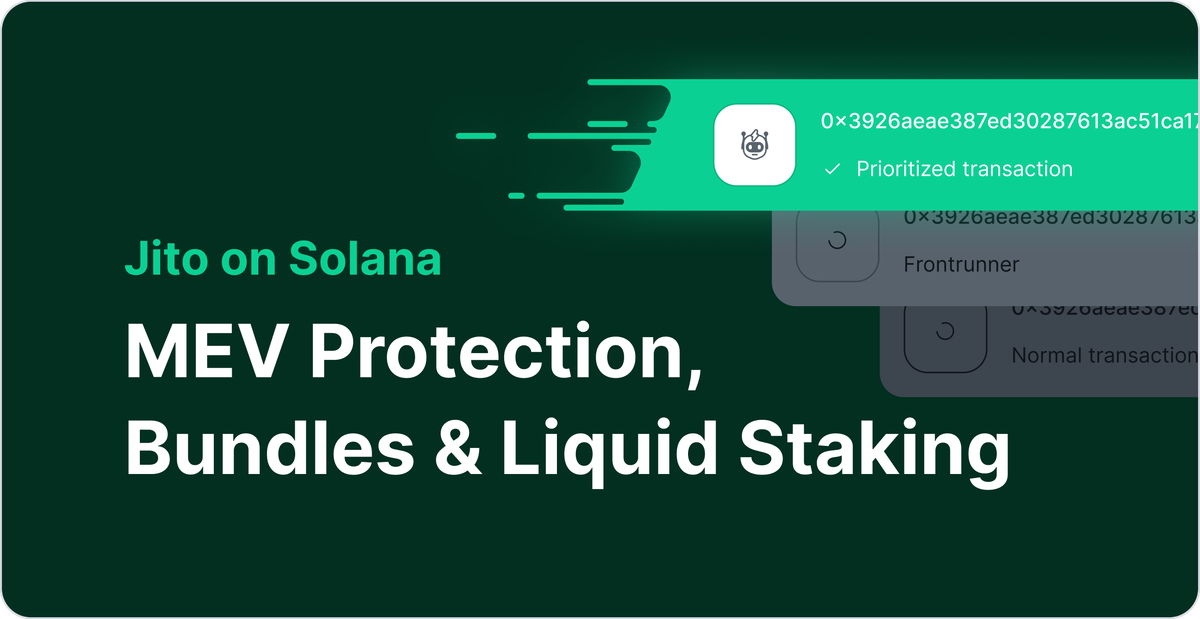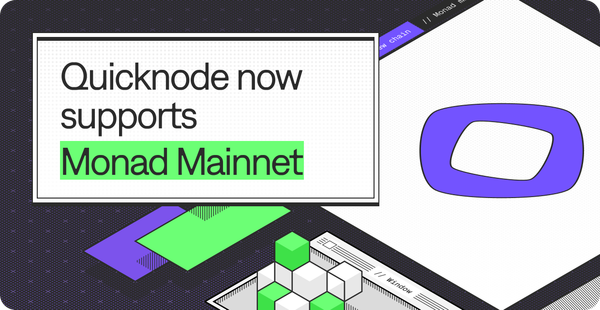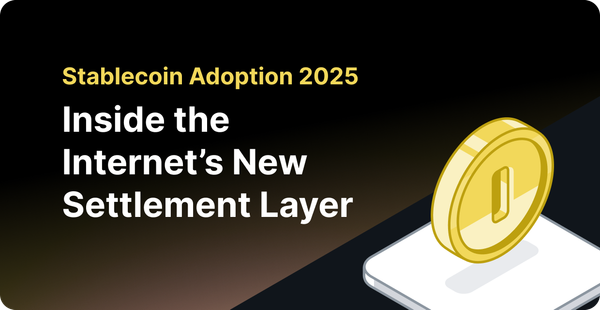Solana MEV Economics: The Role of Jito, Bundles, and Liquid Staking
Learn how Solana's $7.5B MEV economy works through Jito bundles, liquid staking, and validator infrastructure.

Key Takeaways
- Solana’s MEV layer is real and growing. It influences how transactions are ordered, executed, and monetized, especially at scale.
- Two markets compete for blockspace: priority fees and bundle auctions. Standard transactions use tips; high-value flows use Jito bundles for atomic execution.
- Jito controls the MEV stack: validator software, relay infrastructure, and staking. Over 95% of stake flows through this system, reshaping how value moves on Solana.
- Not all MEV is harmful. Bundles enable value-creating strategies like protected arbitrage and cross-protocol coordination.
- Developers must design MEV-aware transactions. Use bundles, simulate fees, and route sensitive flows through private relays.
Since day one, Solana has focused on delivering unmatched speed and throughput, making it a go-to choice for high-performance blockchain applications. This approach has fueled massive on-chain activity, drawing in developers, retail users, and institutions alike. Its emphasis on performance continues to shape a vibrant and growing ecosystem.
But as transaction volume surged, a second economic layer emerged beneath the protocol: MEV.
Maximal Extractable Value is quietly reshaping how transactions are ordered, validators are incentivized, and staking yields are optimized. For developers and validators, this creates both risk and opportunity:
- Risk in the form of predatory transaction behavior.
- Opportunity in the form of new primitives for execution, protection, and yield.
In this blog, we will unpack the MEVs are inherently harmful. On Solana, MEVsmechanics, incentives, and infrastructure behind MEV on Solana and what it means for those building in its future.
The Economic Foundation: Understanding MEV on Solana
Maximal Extractable Value (MEV) refers to the value that can be captured by reordering, including, or excluding transactions within a block.
It’s not a Solana-specific phenomenon but Solana’s unique architecture has given rise to a distinct form of MEV with its own actors, flows, and consequences.
Unlike Ethereum, Solana doesn’t have a public mempool. Transactions are sent directly to upcoming block leaders using a system called Gulf Stream. This cuts down latency and front-running opportunities in theory but in practice, it doesn’t eliminate MEV. It just moves it elsewhere in the stack.
MEV on Solana happens closer to the validator and the infrastructure that feeds them: searchers, relays, and block engines.
Instead of MEV bots monitoring a public mempool, they now operate through private channels and bundling mechanisms.
The result is a more sophisticated but less transparent MEV ecosystem.
The Result: A Two-Layered Market Structure
Solana's MEV economy operates through two complementary mechanisms:
- Priority Fees: Solana's native system allows users to pay additional fees for guaranteed transaction inclusion.
Higher priority fees increase the likelihood of execution during network congestion.
- Bundle Auctions: Private systems like Jito's bundle marketplace where searchers bid for guaranteed transaction ordering and atomic execution.
This creates a dual-track system:
- Retail or standard transactions compete through priority fees
- High-value, coordinated transactions compete through bundle auctions
Who Extracts Value and Why
The Solana MEV economy is shaped by a triangle of incentives:
- Searchers design bots that scan Solana for profitable opportunities: arbitrage, liquidations, NFT mints, etc.
- Validators control blockspace. They choose which transactions to include and in what order.
- Relays and block engines like Jito sit in between, running private auctions to determine which bundles get passed to the validator leader.
Note: Jito's role is particularly significant. They operate as validator (controlling 95% of network stake), relay system, and liquid staking provider simultaneously.
Blockspace as the Ultimate Market
All of this complexity boils down to one fundamental truth: Solana blockspace is the market.
Transactions that pay higher tips, offer bundled economic value, or provide better execution guarantees are prioritized. Those that don't risk getting dropped, especially under congestion or when competing with MEV-optimized bundles.
Value Creation vs Value Extraction in Solana MEV
Not all MEV are inherently harmful. On Solana, MEV can either create value by improving network efficiency or extract value by degrading user outcomes.
Extractive MEV
Extractive MEV takes value from existing transactions without adding utility. Classic examples include:
- Sandwich attacks: Front-running and back-running user trades to capture slippage
- Toxic arbitrage: Exploiting price differences by degrading execution for regular users
- Liquidation sniping: Racing to liquidate positions for maximum profit regardless of user impact
Value-creating MEV
Value-creating MEV improves market efficiency while generating profit:
- Cross-DEX arbitrage: Balancing prices across exchanges, reducing spreads for all users
- Just-in-time liquidity: Providing liquidity exactly when needed, improving market depth
- Coordinated liquidations: Liquidating underwater positions efficiently while minimizing market impact
Solana's Bundle Architecture Enables Value Creation
Jito's bundle system allows multiple transactions to execute atomically, enabling new value-creating strategies:
- Protected arbitrage: Searchers can include user protection mechanisms within profitable bundles
- Shared MEV: Bundles can distribute extracted value back to users or protocols
- Cross-protocol coordination: Complex multi-step operations that benefit all participants
This architectural advantage means Solana MEV doesn't have to be zero-sum.
For developers and validators, aligning with value-creating MEV is both economically sustainable and reputation-safe.
The Infrastructure Supply Chain of Solana MEV
Solana’s MEV economy isn’t just shaped by what transactions aim to do, but where they’re routed, how they’re packaged, and who gets to include them in a block. And that brings us to the infrastructure layer: the machinery behind execution, prioritization, and revenue distribution.
The Flow of Value in Solana MEV
When a user submits a transaction on Solana, it enters a complex routing system:
- Transaction Submission: Users send transactions directly to upcoming block leaders via Gulf Stream
- Bundle Assembly: Searchers package profitable opportunities into atomic bundles
- Auction Mechanisms: Both individual transactions (via priority fees) and bundles (via tip auctions) compete for inclusion
- Validator Selection: Block leaders choose which transactions and bundles to include based on economic value
- Value Distribution: MEV profits flow back through the system to validators, stakers, and sometimes users
At the center of this system is Jito, the dominant player coordinating MEV across Solana’s validator set, transaction relays, and staking layer.
Jito’s Role in Solana MEV Supply Chain
Jito operates across three critical layers:
- Validator client (Jito-Solana),
- Block engine (bundle marketplace and relay), and
- Liquid staking protocol (JitoSOL).
This vertical integration gives Jito end-to-end influence over how MEV is discovered, captured, and distributed on Solana.
Today, over 95% of Solana’s active stake is delegated to validators running the Jito-Solana client.
This client introduces support for bundle auctions, allowing validators to receive pre-ordered transaction packages from Jito’s block engine, prioritized by tips.
As a result, blockspace is no longer filled purely by native transaction queues, it’s actively auctioned off to the highest-value bundles submitted by searchers.
The end result: validators earn additional revenue through MEV tips, and the entire block is more economically optimized but also more centralized.
Liquid Staking Value Layers
With JitoSOL, Jito also acts as a MEV-aware liquid staking provider, distributing MEV-derived revenue back to delegators.
In traditional staking, rewards come from inflation and transaction fees.
With JitoSOL, a third component is added: MEV tips collected by the validator during bundle auctions. These tips are pooled and distributed to JitoSOL holders, boosting staking yields beyond the base protocol rate.
The MEV economy creates both risks and opportunities for developers. Understanding available protection mechanisms and bundle solutions determines whether applications thrive or struggle in Solana's competitive environment.
Build with MEV in Mind: A Developer’s Quick Guide
Design begins at the transaction layer.
A modern Solana application should wire the following logic into their transaction builder so every outbound request is ‘MEV-aware’ by design.
MEV Protection and Transaction Privacy
Even well-formed transactions can leak alpha if they traverse public paths. Private relays mitigate this risk.
- Encrypt or relay: Wrap high-value transactions in an encrypted payload or route them through a private mempool to prevent searcher visibility.
- Fail-open fallback: Always provide a public-RPC fallback; protected routes can occasionally time out.
Tip: The MEV Protection add-on by QuickNode forwards Solana transactions through Merkle’s private relay, shielding them from sandwich and back-run attacks while redistributing any captured MEV back to the sender.
Working with Bundles
Bundles are the workhorse of Solana’s MEV-native design. Key guidelines:
- Transaction ordering: Place the highest-tip instruction in the final transaction; the validator checks this first.
- Tip sizing: A minimum of 1 000 lamports is required, but competitive bundles generally attach 10–50k lamports to outbid background traffic during peaks.
- Simulation before submission: Always simulateBundle in a sandbox slot to verify compute limits, nonce validity, and downstream program states.
- Single-slot finality expectations: Bundles are accepted or rejected atomically in the leader’s slot; plan retries with fresh nonces on rejection.
Lil’ JIT is QuickNode’s Jito add-on that simplifies bundle implementation by providing direct access to Jito's bundle infrastructure through existing RPC endpoints. This eliminates the complexity of managing separate validator connections while maintaining full bundle functionality.
Smart Staking and Yield Strategy
MEV tips now comprise a meaningful share of staking returns on Solana. Protocol treasuries, DAOs, and individual builders should treat validator selection as an active yield optimization strategy rather than a set-and-forget decision.
*Base staking yields ~7%, MEV component varies significantly with network activity **During high MEV periods only; sustainable yields typically 1-2% lower
Delegating to MEV-sharing validators does more than boost yield:
- Predictable tips: Validators running Jito-Solana expose stable tip revenue > network average.
- Network health: Higher stake on MEV-optimized validators reduces failed slots and missed bundles.
- DAO alignment: Treasury yield scales with network efficiency, not inflation alone.
QuickNode operates a 0%-commission Solana validator that passes 100% of MEV tips to delegators.
Getting Started with MEV-Native Development
For developers ready to build in this environment, QuickNode provides comprehensive infrastructure through the Solana marketplace:
- Native Jito bundle support through Lil' JIT
- Priority fee optimization with qn_estimatePriorityFees
- MEV protection services from multiple providers
- Enterprise-grade reliability with global edge network coverage
MEV-aware architecture is quickly becoming the base standard for serious Solana projects. Transaction privacy, dynamic fee logic, and bundle orchestration protect user value. Validator and staking decisions convert previously invisible MEV into transparent, shareable yield.
QuickNode’s plug-ins: MEV Protection for private routing, Lil’ JIT for bundle submission, smart transaction RPCs for fee estimation, and a 0 %-fee validator provide turnkey access to this toolkit, letting teams adopt best practices without operating bespoke infrastructure.
The result: safer execution, higher yield, and applications aligned with the economic realities of Solana’s next growth phase.
About QuickNode
QuickNode provides the tools and resources builders need to create incredible products. With a globally balanced infrastructure, guaranteed reliability, a user-friendly interface, and end-to-end customer support, QuickNode allows enterprises to realize their ideas on the chain rapidly.





